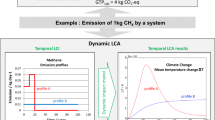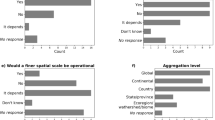Abstract
Purpose
Because the potential impacts of emissions and extractions can be sensitive to timing, the temporal aggregation of life cycle inventory (LCI) data has often been cited as a limitation in life cycle assessment (LCA). Until now, examples of temporal emission and extraction distributions were restricted to the foreground processes of product systems. The objective of this paper is to evaluate the relevance of considering the temporal distribution of the background system inventory.
Methods
The paper focuses on the global warming impact category for which so-called dynamic characterization factors (CFs) were developed and uses the ecoinvent v2.2 database as both an example database to which temporal information can be added and a source of product systems to test the relevance of adding temporal information to the background system. Temporal information was added to the elementary and intermediate exchanges of 22 % of the unit processes in the database. Using the enhanced structure path analysis (ESPA) method to generate temporally differentiated LCIs in conjunction with time-dependent global warming characterization factors, potential impacts were calculated for all 4,034 product systems in the ecoinvent database.
Results and discussion
Each time, the results were calculated for (1) systems in which temporal information was only added to the first two tiers, representing studies in which only the foreground system is temporally differentiated, and (2) systems in which temporal information was also added to the background system. For 8.6 % of the database product systems, adding temporal differentiation to background unit processes affected the global warming impact scores by more than 10 %. For most of the affected product systems, considering temporal information in the background unit processes decreased the global warming impact scores. The sectors that show most sensitivity to the temporal differentiation of background unit processes are associated with wood and biofuel sectors.
Conclusions
Even though the addition of temporal information to unit processes in LCI databases would not benefit every LCA study, the enhancement can be relevant. It allows for a more accurate global warming impact assessment, especially for LCAs in which products of biomass are present in substantial amounts. Relevance for other impact categories could be discussed in further work.








Similar content being viewed by others
References
Bare JC, Pennington DW, Udo de Haes HA (1999) Life cycle impact assessment sophistication. Int J Life Cycle Assess 4(5):299–306
Beloin-Saint-Pierre D, Heijungs R, Blanc I (2014) The ESPA method: a solution to an implementation challenge of dynamic life cycle assessment studies. Int J Life Cycle Assess 19(4):861–871
Bourgault G, Lesage P, Samson R (2012) Systematic disaggregation: a hybrid LCI computation algorithm enhancing interpretation phase in LCA. Int J Life Cycle Assess 17(6):1–13
Cherubini F, Peters GP, Berntsen T, Stromman AH, Hertwich E (2011) CO2 emissions from biomass combustion for bioenergy: atmospheric decay and contribution to global warming. GCB Bioenergy 3(5):413–426
Collet P, Lardon L, Steyer J-P, Hélias A (2014) How to take time into account in the inventory step: a selective introduction based on sensitivity analysis. Int J Life Cycle Assess 19(2):320–330
Cucurachi S, Heijungs R, Ohlau K (2012) Towards a general framework for including noise impacts in LCA. Int J Life Cycle Assess 17(4):471–487
ecoinvent (2013) The ecoinvent database. http://www.ecoinvent.org/database/. Accessed Aug 2013
European Commission (2011) International Reference Life Cycle Data System (ILCD) handbook‚ recommendations for life cycle impact assessment in the European context. Joint Research Centre‚ Institute for Environment and Sustainability Publications Office of the European Union, Luxembourg
eurostat (2013) Transport database. http://epp.eurostat.ec.europa.eu/portal/page/portal/transport/data/database. Accessed Sept 2013
Forster P, Ramaswamy V, Artaxo P, Berntsen T, Betts R, Fahey DW et al (2007) Changes in atmospheric constituents and in radiative forcing. In: Solomon S, Quin D, Manning M, Chen Z, Marquis M, Averyt KB (eds) Climate change 2007: the physical science basic. Contribution of Working Group I to the Fourth Assessment Report of the Intergovernmental Panel on Climate Change. Cambridge University Press, Cambridge, pp 129–234
Guo M, Murphy RJ (2012) LCA data quality: sensitivity and uncertainty analysis. Sci Total Environ 435-436:230–243
Hauschild MZ, Udo de Haes H, Finnveden G, Goedkoop M, Hertwich E, Hofstetter P, Klöpffer W, Krewitt W, Lindeijer E (2002) Life cycle impact assessment: striving towards best practice. SETAC Press, Brussels
Huijbregts MAJ, Guinee JB, Reijnders L (2001) Priority assessment of toxic substances in life cycle assessment. III: Export of potential impact over time and space. Chemosphere 44(1):59–65
Humbert S, Rossi V, Margni M, Jolliet O, Loerincik Y (2009) Life cycle assessment of two baby food packaging alternatives: glass jars vs. plastic pots. Int J Life Cycle Assess 14(2):95–106
IPCC (2000) Land use. Land-use Change and Forestry, Cambridge
Kendall A, Price L (2012) Incorporating time-corrected life cycle greenhouse gas emissions in vehicle regulations. Environ Sci Technol 46(5):2557–2563
Kendall A, Chang B, Sharpe B (2009) Accounting for time-dependent effects in biofuel life cycle greenhouse gas emissions calculations. Environ Sci Technol 43(18):7142–7147
Lebailly F, Levasseur A, Samson R, Deschênes L (2013) Considering temporal variability for the characterization of metals aquatic ecotoxicity impacts in LCA. In: 23rd SETAC Europe, Glasgow, Scotland, 2013
Levasseur A, Lesage P, Margni M, Deschênes L, Samson R (2010) Considering time in LCA: dynamic LCA and its application to global warming impact assessments. Environ Sci Technol 44(8):3169–3174
Levasseur A, Brandão M, Lesage P, Margni M, Pennington D, Clift R, Samson R (2011) Valuing temporary carbon storage. Nat Clim Chang 2(1):6–8
Levasseur A, Lesage P, Margni M, Brandão M, Samson R (2012a) Assessing temporary carbon sequestration and storage projects through land use, land-use change and forestry: comparison of dynamic life cycle assessment with ton-year approaches. Clim Chang 115(3–4):1–18
Levasseur A, Lesage P, Margni M, Samson R (2012b) Biogenic carbon and temporary storage addressed with dynamic life cycle assessment. J Ind Ecol 17(1):117–128
Manneh R, Margni M, Deschênes L (2012) Evaluating the relevance of seasonal differentiation of human health intake fractions in life cycle assessment. Integr Environ Assess Manag 8(4):749–759
O’Hare M, Plevin RJ, Martin JI, Jones AD, Kendall A, Hopson E (2009) Proper accounting for time increases crop-based biofuels’ greenhouse gas deficit versus petroleum. Environ Res Lett 4:024001
Peters GP (2007) Efficient algorithms for life cycle assessment, input-output analysis, and Monte-Carlo analysis. Int J Life Cycle Assess 12(6):373–380
Phungrassami H (2008) A review of time consideration in life cycle assessment. Glob J Environ Res 2(2):62–65
Potting J, Schöpp W, Blok K, Hauschild M (1998) Site-dependent life-cycle impact assessment of acidification. J Ind Ecol 2(2):63–87
Reap J, Roman F, Duncan S, Bras B (2008) A survey of unresolved problems in life cycle assessment. Int J Life Cycle Assess 13(5):374–388
Shah VP, Ries RJ (2009) A characterization model with spatial and temporal resolution for life cycle impact assessment of photochemical precursors in the United States. Int J Life Cycle Assess 14(4):313–327
Sich B, Barlaz M (2000) Life-cycle inventory of landfill gas. In: Process model documentation: calculation of the cost and life-cycle inventory for waste disposal in traditional, bioreactor and ash landfills. North Carolina State University, p 225
Suh S, Heijungs R (2007) Power series expansion and structural analysis for life cycle assessment. Int J Life Cycle Assess 12(6):381–390
UNEP (2011) Global guidance principles for life cycle assessment databases a basis for greener processes and products
Weidema B, Bauer C, Hischier R, Mutel C, Nemecek T, Reinhard J, Vadenbo C, Wernet G (2013) Overview and methodology: data quality guideline for the ecoinvent database version 3. St Gallen, ecoinvent (1)
Acknowledgments
The International Life Cycle Chair (a research unit of the CIRAIG) would like to acknowledge the financial support of its industrial partners: ArcelorMittal, Bell Canada, Bombardier, Cascades, Eco Entreprises Québec, Groupe EDF, GDF SUEZ, Hydro-Québec, Johnson & Johnson, LVMH, Michelin, Mouvement des caisses Desjardins, Nestlé, RECYC-QUÉBEC, Rio Tinto Alcan, RONA, SAQ, Solvay, Total, Umicore and Veolia Environnement.
Author information
Authors and Affiliations
Corresponding author
Additional information
Responsible editor: Mark Huijbregts
Electronic supplementary material
Below is the link to the electronic supplementary material.
ESM 1
(DOCX 1295 kb)
Rights and permissions
About this article
Cite this article
Pinsonnault, A., Lesage, P., Levasseur, A. et al. Temporal differentiation of background systems in LCA: relevance of adding temporal information in LCI databases. Int J Life Cycle Assess 19, 1843–1853 (2014). https://doi.org/10.1007/s11367-014-0783-5
Received:
Accepted:
Published:
Issue Date:
DOI: https://doi.org/10.1007/s11367-014-0783-5




